Making as evidence of transferable skills around Vermont
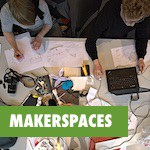 During the past year, EMMA has visited schools around Vermont to fuel the conversation about maker-centered learning.
During the past year, EMMA has visited schools around Vermont to fuel the conversation about maker-centered learning.
As we reflected on each of EMMA’s visits, we continually noticed that maker centered learning provided evidence of students applying cross-disciplinary transferable skills.
Who or what is EMMA?
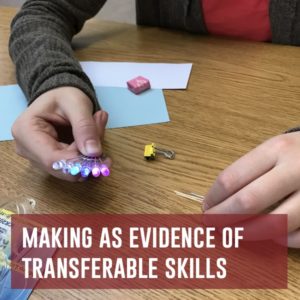 EMMA’s not a person but a fun mobile studio for creating and making. A little red car that Lucie adopted in 2015 as a way to bring creating and making to underrepresented populations. EMMA makes it so that Everyone May Make Anywhere.
EMMA’s not a person but a fun mobile studio for creating and making. A little red car that Lucie adopted in 2015 as a way to bring creating and making to underrepresented populations. EMMA makes it so that Everyone May Make Anywhere.
And during the past year, EMMA and Lucie (and sometimes Life) have been visiting schools around Vermont, providing learners with access to maker-centered learning activities such as laser cutting, 3D printing, and papercraft incorporating LED lights and sounds.
On our visits, what we noticed was that maker-centered learning can certainly be used to develop specific STEM/STEAM based skills as well as specific content skills, but one of the areas that maker-centered learning excels in is providing evidence of the transferable skills articulated in Vermont’s Educational Quality Standards:
- Clear and Effective Communication
- Self-Direction
- Creative and Practical Problem Solving
- Responsible and Involved Citizenship
- Integrative and Informed Thinking
This is very much in line with the the Agency by Design extensive research study by Harvard’s Project Zero that revealed that disciplinary-specific and even maker-specific skills and content were secondary outcomes of maker-centered learning. The primary outcomes of maker-centered learning were actually the development of student agency and character.
[huge_it_slider id=”16 “]
At these EMMA visits to Vermont schools, we were able to see and reflect on evidence of growth of each of the transferable skills.
We believe that using the language found in the Vermont Transferable Skills Assessment Supports (VTSAS) to reflect on maker centered learning activities can help students reflect on and thus strengthen their learning. Furthermore, documenting maker-centered learning can create evidence of growth and proficiency that students can add to their learning portfolios.
Just as EMMA is a vehicle that supports making, we believe that maker-centered learning is a vehicle for growing and showing cross-curricular skills.
This is the first of five posts where we will present evidence for each of Vermont’s transferable skills, starting here with communication.
Transferable Skill: “Clear and Effective Communication”
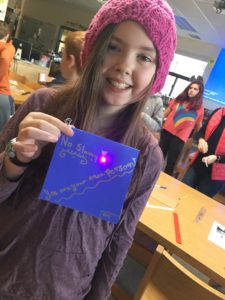
Even though maker-centered learning generates evidence of all five transferable skills, probably the one that is easiest to spot is that of Clear and Effective Communication.
Cardboard, laser cutters, 3D printers, light, sound, paper, markers, tape, and pens provide us with so many different ways to communicate! A makerspace allows us to expand the dimensions of what we consider as clear and effective communication.
How paper circuits can develop clear and effective communication skills
In three of EMMA’s visits to Vermont schools, students were challenged to use light to emphasize an idea that they would like to communicate. After a brief introduction to paper circuits, students were ready to take on this challenge.
Two group of students at Crossett Brook Middle School created a message around human rights. Two others groups of students from Crossett Brook focused on sustainability, using paper circuits to summarize and reflect on learning at the end of a unit.
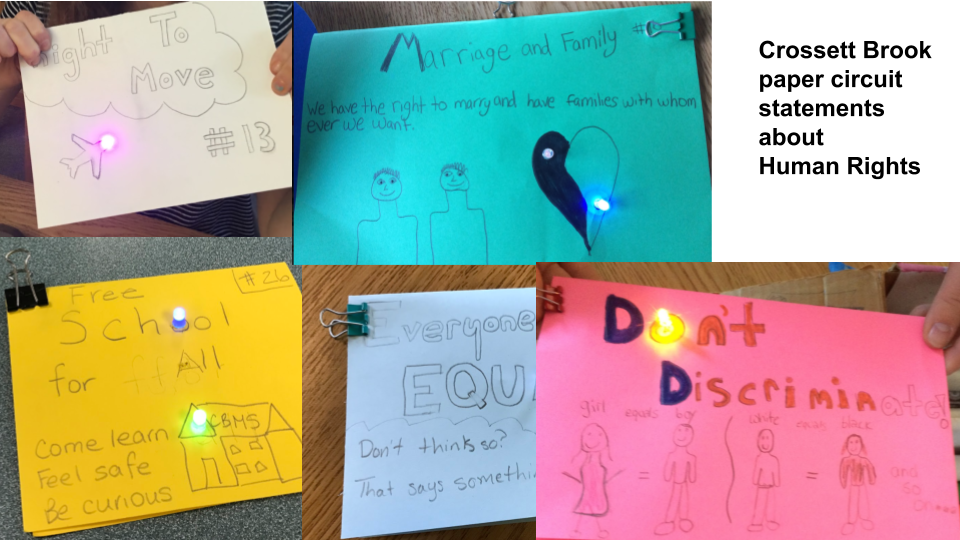
Meanwhile, students at West Rutland School used the creation of a paper circuit to launch a unit of study around personalized narratives.
Identifying a focal point for your personal narrative is not always easy. While some students might stare at a blank piece of paper struggling with what they should write about, these same students quickly engaged with batteries, LEDs, and copper tape to create a paper circuit about something that “lights them up.” For students who think with their hands, this 90-minute challenge provided a hands-on / minds-on way to generate possible focus ideas for their personal narratives.
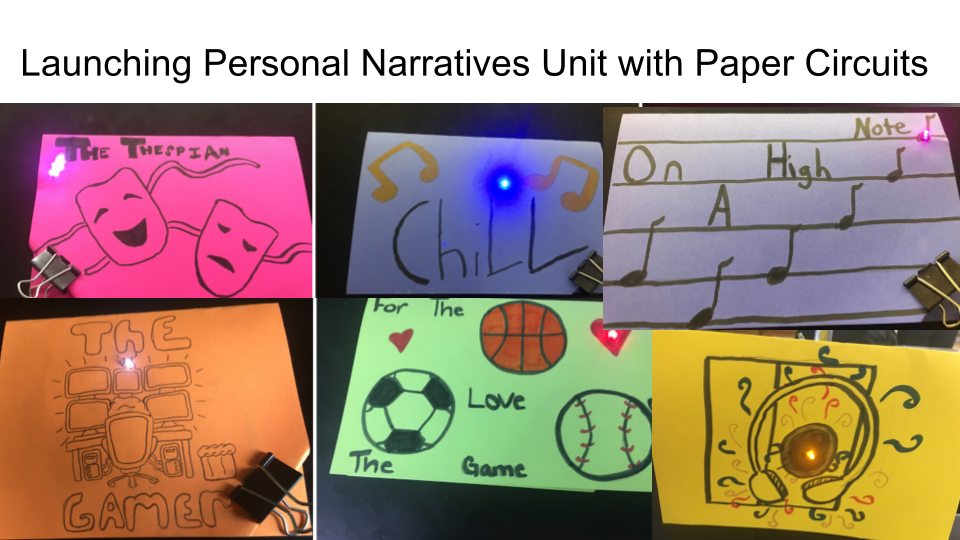
Explaining that many times a movie poster is created long before the movie is filmed, we suggested that the students think about their “what lights me up” paper circuit as an illuminated movie poster, or a preview of their upcoming personal narrative movie.
At Shelburne Community School, students created paper circuit artifacts to express their initial thinking about conflicts and society at the start of a new unit of study.
This allowed the students to think more deeply about “What do you KNOW about a topic?” than they might have done using a traditional worksheet. The topics they chose for their paper circuit also shed light on what MATTERED to them as a learner. An observant teacher could then use that information to help students make connections to this very important curricular topic in a more personal way.
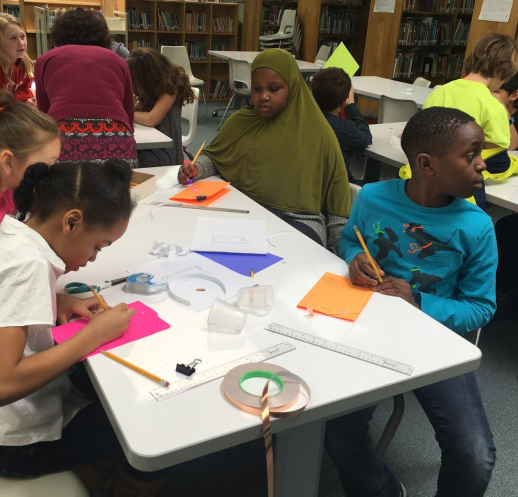
The act of MAKING a tangible artifact with paper, copper tape, lights, and batteries allowed students to demonstrate effective, expressive communication. In each case the students’ artifacts were organized and purposeful.
Whether the topic was human rights or conflicts in society, students carefully considered evidence around their topic and how light might effectively be used to illuminate their message.
The paper circuit projects that emerged were clear evidence of effective communication from students at each of the schools EMMA visited.
The paper circuit type of making directly connects with many of the performance indicators for Clear and Effective Communication. Most obviously, it provides a unique framework whereby students are “adjusting communication” based on audience and purpose. Students are asked to “integrate information” to “present ideas coherently,” and then use technology and visual imagery to “further enhance” their message. This also forces them to craft communication that is “organized and purposeful,” unleashing creativity within constraints.
Could paper and markers have had the same impact? Perhaps for some!
But for many students, moving the focus away from “what I draw or type” to “what I MAKE” allowed ideas and concepts to emerge in a more concrete way. For students who think with their hands, the ideas don’t come BEFORE the making, they come through the making. It might be tempting to have students sketch their ideas BEFORE they come to the makerspace or before you introduce the new tools for communicating, but providing a new space and a new modality in which to communicate really leverages the power of making as a vehicle for learning and communicating.
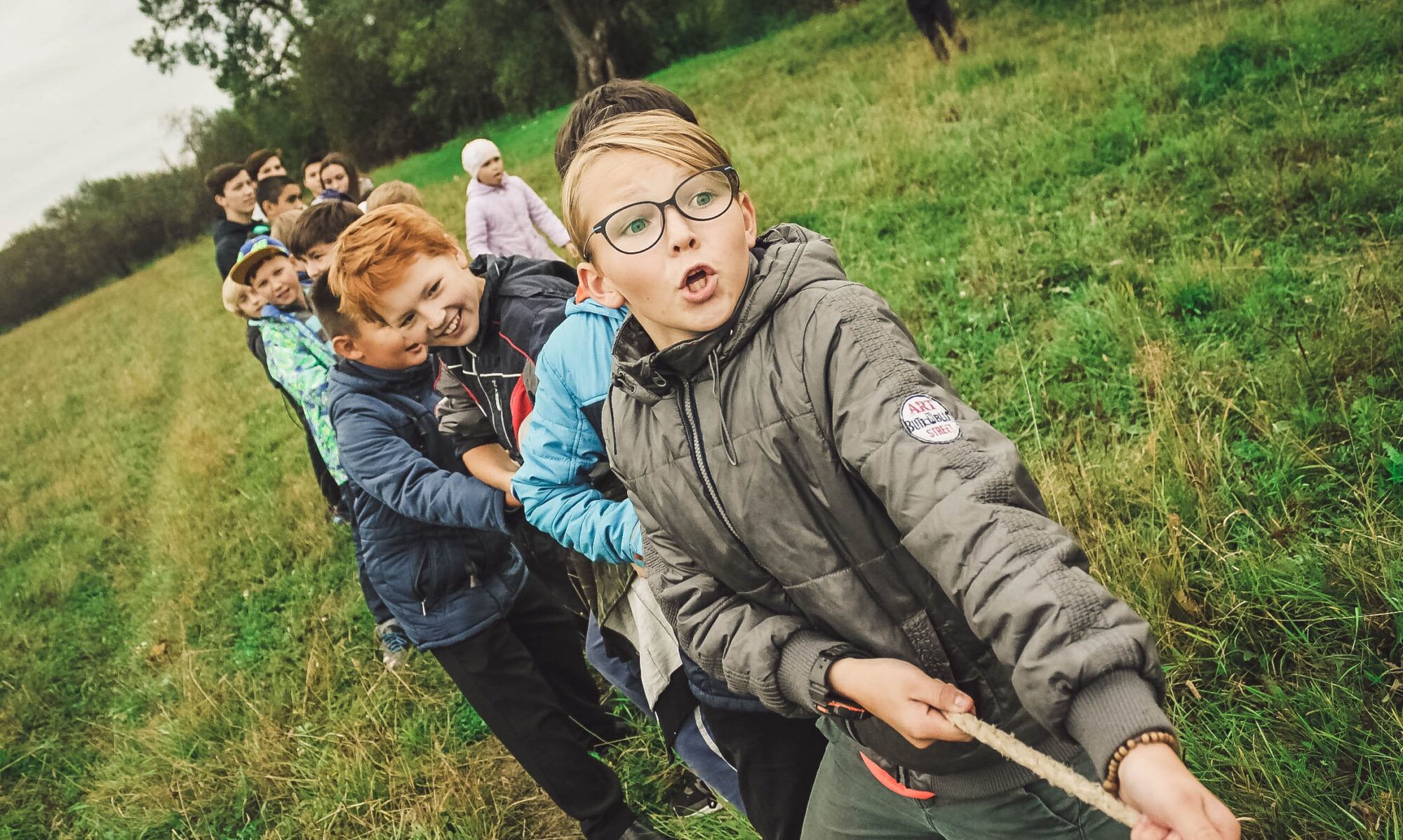

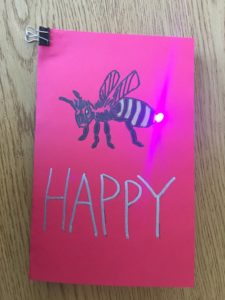
One Reply to “The Maker Movement and transferable skills”
Comments are closed.